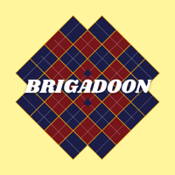
Overview
Synopsis
When New Yorkers Tommy Albright and Jeff Douglas get lost on a vacation in the Scottish Highlands, they stumble into Brigadoon. Brigadoon is a mythical village that, they learn, appears for a single day once every hundred years. At first, Tommy and Jeff are mystified by the villagers’ 18th century garb as they go to market, but they are soon charmed by romantic liaisons: Tommy, who is engaged back in New York, falls terribly in love with headstrong Fiona, while Jeff enjoys a harmless flirtation with Meg Brockie. It is only when Harry Beaton, the rejected suitor of Fiona’s sister, Jean, tries to leave Brigadoon that the two men realize the complicated truth: at the end of the day, this town will disappear into the mist for the next hundred years – and if anyone succeeds in leaving Brigadoon, the town and the people in it will be lost, forever. Tommy is forced to choose between returning to the world that he knows and his New York fiance — or taking a chance on life and love in a mysterious new place. Including such famous hits as “Heather on the Hill” and “Almost Like Being in Love,” Lerner and Loewe’s Brigadoon has music that will sweep you off your feet and a whimsical story that is a tribute to the power of true love.
Show Information
Context
When Brigadoon premiered on Broadway in 1947, Alan Jay Lerner (book and lyrics) and Frederick Loewe (music) were still establishing themselves as a writing team. Their collaboration on this show was a turning point, securing them recognition as creators of sophisticated, romantic musicals. The story’s mystical blend of love, sacrifice, and folklore resonated with audiences seeking escapism in the years following World War II.
Lerner’s book was not an adaptation of an existing play or novel
to read the context for Brigadoon and to unlock other amazing theatre resources!Plot
Characters
| Name | Part Size | Gender | Vocal Part |
|---|---|---|---|
|
Lead |
Male |
Tenor |
|
|
Lead |
Female |
Soprano |
|
|
Supporting |
Male |
Spoken |
|
|
Supporting |
Male |
Spoken |
|
|
Supporting |
Male |
Baritone |
|
|
Supporting |
Female |
Mezzo-Soprano |
|
|
Supporting |
Female |
Alto |
|
|
Supporting |
Male |
Spoken |
|
|
Supporting |
Male |
Tenor |
|
|
Featured |
Female |
|
|
|
Featured |
Male |
|
|
|
Featured |
Male |
Bass |
|
|
Featured |
Female |
Silent |
|
|
Featured |
Female |
Tenor |
|
|
Featured |
Male |
Baritone |
|
|
Featured |
Male |
Spoken |
|
|
Featured |
Male |
Spoken |
|
|
Featured |
Female |
|
|
|
Featured |
Female |
Spoken |
|
|
Ensemble |
Male |
Silent |
|
|
Ensemble |
Male |
Silent |
|
|
Ensemble |
Either Gender |
|
Songs
Act One
Act Two
A song with an asterisk (*) before the title indicates a dance number.
Monologues
Scenes
Key Terms
A musical with a well-structured narrative that integrates songs, dialogue, and dance to advance plot and character development.
Counterpoint is a musical technique where two or more independent melodies are combined and performed simultaneously. Each line maintains its own rhythm and contour, yet together they create harmonic richness and complexity. This interplay adds texture, depth, and dynamic contrast to a piece of music.
A diegetic song is a musical number that exists within the world of the story, where the characters are aware they are singing. It is typically performed as part of the plot, such as at a concert, celebration, or personal expression witnessed by other characters. Unlike non-diegetic songs, it is justified within the narrative and functions as a natural extension of the character’s environment.
Occurs when the audience knows more than the characters on stage, creating tension, humor, or poignancy.
A period of artistic flourishing, often referring to 1940s-60s Broadway or English Renaissance theatre. This term plays a vital role in understanding theatrical structure and is commonly encountered in stagecraft or performance settings.
The “Golden Age Musical” refers to Broadway shows written roughly between the 1940s and 1960s, a period known for integrating songs, story, and character development. These musicals often balanced romance, comedy, and social themes with memorable melodies and large ensembles. Classics from this era continue to shape the foundation of modern musical theatre.
Videos
Quizzes
Themes, Symbols & Motifs
Themes
Love and Sacrifice: At its heart,
to read about the themes, symbols and motifs from Brigadoon and to unlock other amazing theatre resources!Quote Analysis
Sorry! We do not currently have learning modules for this guide.
